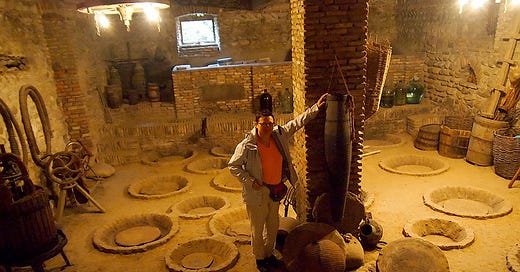Qvevri 11-29-2023
It seems inevitable. Whatever is “in” eventually will be “out.” Whatever is out eventually will be the next big thing. In the wine world, orange/amber wine and qvevri are examples.
Orange/amber wine is made in the simplest way. Grapes are dumped in a container and nature takes its course. In this process, the juice from white grapes is not removed from the skins, stems, and seeds, and thus the orange/amber color. This “natural” wine is the next big thing.
Qvevri at Georgian winery
Tomasz Przechlewski
Except not in the nation of Georgia at the nexus of Europe and Asia next to the Black Sea. Georgia very likely is where humans first started making wine more than 8,000 years ago. It is where the oldest wine-making site has been discovered. The Georgian language word for wine is “ghvino”, which means our word “wine” likely has its origin in Georgia.
Georgian winemaking suffered under Communism. It began a roaring comeback with the fall of the Soviet Union in 1989. The traditional method of making wine in Georgia involves use of qvevri—also spelled kvevri. A qvevri/kvevri is a large, egg-shaped terra-cotta vessel. It is similar to amphorae, but does not have handles. Qvevri range in size from 6 gallons to 2,600 gallons. The clay used to produce qvevri is important because it influences taste. It is similar to the choice of oak barrels in Western winemaking. It is related to the current Western winemaking trend to concrete eggs.
The inside of the qvevri is coated with beeswax to soften the clay impact. In most cases, qvevri are buried in the ground with only the circular mouth showing. The prefix qve/kve means “beneath” or “under.” The earth burial helps provide consistent temperature. A qvevri is a permanent winemaking vessels, cleaned, re-coated with beeswax and used year after year. Some actively-used qvevri are approaching 200 years old. Qvevri remnants in Georgia date back thousands of years.
In Georgia winemaking, grapes are pressed then the juice, grape skins, stalks, and pips are poured into the qvevri. The wine ferments at least six months with native yeasts. Usually malolactic fermentation is spontaneous. With white wine, the extended contact with the skins, stalks, and pips causes the wine color to be orange or amber. The method often is described as making white wine using red wine techniques.
You may have to search for Georgian qvevri wines, but it will be worth the adventure so you can be part of the next big thing that is thousands of years old.
Last round
What kind of soap does a dolphin use? An all-porpoise cleaner. Wine time.
Email: wine@cwadv.com
Newsletter: gusclemens.substack.com
Website: gusclemensonwine.com
Facebook: facebook.com/GusClemensOnWine/posts/
Twitter (X): @gusclemens
Since you subscribe to my newsletter, it follows you enjoy wine and humor and are an adventurous, inquisitive person. Each morning, The Sample sends you one article from a random blog or newsletter that matches your interests. When you find one you like, you can subscribe to the writer with one click. Give it a try Link to The Sample















Share this post